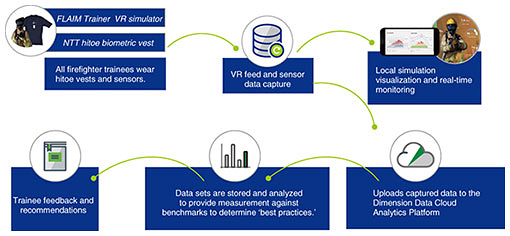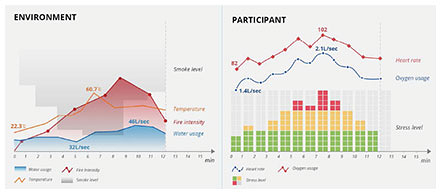 |
|||||||||||||||||||||||
|
|
|||||||||||||||||||||||
|
Feature Articles: Value Creation by Leveraging State-of-the-art Research Results Vol. 17, No. 2, pp. 24–31, Feb. 2019. https://doi.org/10.53829/ntr201902fa3 Ensuring Greater Safety for Our Firefighters and Our Communities: Integrating FLAIM TrainerTM and hitoeTMAbstractFLAIM TrainerTM is an immersive, virtual reality (VR) firefighter training simulator with biosensing and real-time scenario analytics. It was developed in Australia through research at Deakin University and incorporates a patented digital biosensing fabric developed by NTT called hitoeTM. The hitoe material provides real-time data readings of biomedical signals, for example, electrocardiogram or electromyogram signals. FLAIM Trainer revolutionizes the way emergency services train and prepare to fight fires. The immersive VR, haptics feedback, and breathing simulation provide firefighters with the ability to train for dangerous scenarios that are hard to reproduce in reality, expensive, and environmentally harmful. Keywords: wearable sensor, electrocardiogram, biomedical signal monitoring, haptics, immersive virtual reality, firefighting, emergency services 1. IntroductionNTT subsidiary Dimension Data and FLAIM Systems Pty Ltd., a start-up wholly owned by Deakin University (Melbourne, Australia), have collaborated on the integration of biometric data capture and feedback as part of an immersive virtual reality (VR) firefighting simulator called FLAIM TrainerTM. This has created an enhanced training experience and improved the health and safety of trainees and ultimately their fitness to fight in emergency situations. Under a co-innovation agreement, Deakin University and Dimension Data have integrated NTT’s hitoeTM material (Fig. 1) [1] into FLAIM Trainer. The hitoe biosensing nanofiber material is worn as a vest by the trainee, which tracks electrocardiogram (ECG) readings and transmits the data in real time for analysis of firefighters’ heart rate, stress level, and fatigue during training. The FLAIM Trainer system includes an HTC VIVE VR headset, personal protective clothing with heat generation components, a breathing apparatus simulator, and a patented haptics feedback hose system that provides a unique training experience. With the complementary layer of hitoe, instructors can monitor the trainee’s vital signs as well as physiological response and performance during training. Dimension Data’s Cloud Analytics Platform is used to aggregate the hitoe data with the data captured from the FLAIM Trainer system during training. The data is then displayed alongside the visuals of the training scenario being undertaken (Fig. 2). As the captured data and training session are recorded and stored in a cloud environment or integrated into a learning management system, results can be benchmarked, and instructors can review and track performance over time.
This innovation is unparalleled in the world of VR-based training systems and will have a much broader application in the future for other industry uses. The system not only captures, integrates, and presents live feedback from all devices and sensors, including hitoe, but also enables the trainee and instructor to see how a set of actions (firefighting technique, hose and water or foam use, oxygen consumption and any simulation or scenario-related activity) correlates with and affects performance via heart rate and stress. This will lead to new insights into how we fight fires and better manage the health and safety of our emergency workers. The FLAIM Trainer solution was announced and demonstrated at the launch of Dimension Data’s first Client Innovation Centre (CIC) in Sydney in August 2018. The CIC showcases a number of technologies and solutions developed and co-innovated with the NTT Group and the wider Australian business, government, and academic community [2]. 2. FLAIM Trainer designFLAIM Trainer is a highly configurable and mobile training system that can be easily transported and set up at different locations. The hardware (Fig. 3) consists of:
FLAIM Trainer’s VR simulation produces realistic renders of smoke, fire, water, and foam effects and precisely matches the physical nozzle settings and performance, with five detent flow positions from an optimal straight stream to a fog pattern displayed in the headset for the trainee and on screen for the instructor. The nozzle’s selectable 100/200/300/400/500 l/min @ 500 kPa (5 bar) water pressure control, combined with the flow type, is reflected in the physical force feedback for the trainee created by the haptics system. The mask and breathing apparatus system, worn as an oxygen tank on the trainee’s back, contains all of the electronics and processing to capture and measure the respiration rate of the trainee, the amount of oxygen consumed and whether or not they are communicating effectively during the exercise. The heat suit realistically replicates the heat that would be felt by the trainee in the simulation scenario, including the direct or radiant heat from the fire itself. The heating elements are controlled via the FLAIM Systems software that determines the proximity and orientation to the fire, and other heating effects, and how that affects the individual. From a software and systems perspective, there are five standard scenarios available, with additional and customized scenarios available via subscription to users. These base scenarios and skills training cover hose use, compartment (kitchen) fire, aircraft (foam), gas cylinder cooling (BLEVE: boiling liquid expanding vapor explosion), and vehicle and size-up fires (Fig. 4). In each scenario, data feeds from the various components of the VR simulation and hitoe vest are captured and presented on screen for the instructor in real time. The data is also captured in Dimension Data’s Cloud Analytics Platform, with data sets stored and analyzed to provide measurement against benchmarks, that is, to determine best practices, and for training results to be logged in each trainee’s training record, either in a stand-alone application or the organization’s own learning management system or other professional development or training system. Individual or group feedback and recommendations can then be provided by the instructor based on the reports generated (Fig. 5).
FLAIM Systems has a team of roboticists, modelers, software developers, machinists, fabricators, and engineers who can develop customized solutions and scenarios for specific training exercises and requirements. 3. Stress calculations from hitoeThe calculations of the trainee’s level of physiological stress are completed on the hitoe device and reported to the FLAIM Trainer application as a value of 0 – ~2.3. The FLAIM Trainer software then converts this to a six-bar visual stress indicator, displayed as part of the instructor’s dashboard (Fig. 6).
The stress estimation logic calculates the ratio of high- and low-frequency oscillations (LF/HF) values as one of the feature values employing inter-beat (RR) interval values (RRI) representing the fluctuation of heartbeats. LF: total power of 0.04–0.15 Hz when performing spectral analysis on RRIs; HF: total power of 0.15–0.40 Hz when performing spectral analysis on RRIs; LF/HF: increases when sympathetic nerve activity is activated. 4. Cost and difficulty of traditional trainingOne of the key challenges that FLAIM Trainer addresses is the cost and difficulty of training, which limit the scale and frequency of firefighting training. Those costs include establishing and maintaining purpose-built training facilities, personnel, and travel time and costs for trainees to attend training sessions. For the more complex or extreme scenarios, for example, an aircraft fire, setting these up in a real training facility are virtually impossible or prohibitively expensive. FLAIM Trainer also provides an opportunity for the community and potential recruits to experience what it is like to fight a fire—all at a low cost, in a quick timeframe, and at any possible location. “The Virtual Reality roadshow is underway and is more than likely coming to a location near you! This Virtual Reality tool will help volunteers train for incidents that they may not see on a regular basis.”—Country Fire Authority (CFA) News & Media [3]. Training members of the world’s navies, for instance, has historically been difficult—logistical constraints mean that naval members cannot fully train at sea, as they are constrained in the use of training smoke or the use of fire hoses in the middle of a vessel. Using industry standard equipment and real-world systems in a virtual environment such as with FLAIM Trainer removes those constraints and allows users to train more, train better, and train anywhere. “A big push for the future will be to get Sea Training Group to take FLAIM Trainer to sea, so Navy members get the chance to practice with a greater level of realism in their ships.”—Commander Graeme Bacon, Royal Australian Navy [4]. 5. Reduced environmental impactBy complementing physical training with a fully immersive set of virtual scenarios, FLAIM Trainer can reduce the environmental damage caused by real-life training. It also enables training for scenarios that are no longer possible to carry out due to environmental, community, or regulatory constraints. Traditional firefighter training can cause extensive environmental harm. In a country such as Australia, where many areas are suffering from water shortages and drought conditions, high volume water usage for training purposes can be problematic in that it takes precious and limited water resources away from more essential needs. By-products of traditional training activities such as smoke and other pollutants released through the process of burning substances can have a damaging effect on the surrounding environment and air quality and also contribute to atmospheric damage. Apart from water, the long-term effect of other substances such as per- and polyfluoroalkyl substances (PFAS) used in firefighting foams, has caused contamination of the surrounding areas and health side-effects for populations around the world. The Australian government reported that there are a number of specific sites across Australia where run-off from the historical use of PFAS-containing firefighting foams has resulted in increased levels of PFAS in surrounding soil and water. As an indication of the seriousness of this issue, the Australian Government has set up a dedicated website to provide the community with more information on PFAS contamination [5]. Many jurisdictions around the world have banned or are phasing out the use of firefighting foams containing PFAS chemicals. A number of physical training sites have been closed down due to PFAS contamination across Australia, increasing the cost and availability of firefighter training, and also limiting the amount of training that can be conducted safely with firefighting foams. Furthermore, the potential health impacts associated with exposure are being investigated by an Expert Health Panel for PFAS established to advise the Australian Government [6]. 6. Trainee health and safetyThe use of firefighting foams in training exercises also has a direct impact on the trainees themselves. When these training exercises are replaced with virtual scenarios, there is less exposure over the long term for firefighters to the potentially damaging effects of the chemicals used in firefighting foams. For example, in 2013, Airservices Australia tested 150 firefighters for exposure to toxic chemicals and found that some firefighters had levels of PFOS (polyfluoroalkyl substances)—a type of PFAS chemical—from 10 to nearly 20 times higher than the general population [7]. However, firefighting training in and of itself is inherently dangerous to the health of trainees. With the biosensing data supplied by hitoe, instructors are able to monitor the trainee’s health and safety during the training exercise, alerting them to immediate risks to the trainee’s wellbeing or to underlying health issues that can then be treated to avoid potential harm to the person in future training scenarios or in the field. Training-related injuries and fatalities are a serious concern in the emergency services sector. For instance, the United States Fire Administration (USFA) reported that approximately 11% (141 out of 1305) of the line-of-duty deaths that occurred from 2001 to 2013 were training-related. The leading cause of training-related deaths was heart attacks (50%) followed by traumatic injury (31%). The remaining 19% were other types of cardiovascular disease and other diverse circumstances [8]. During 2001 to 2013, the National Institute for Occupational Safety and Health (NIOSH) investigated 77 training-related fatalities through the Fire Fighter Fatality Investigation and Prevention Program [8] and reported that of those fatalities, 62 (80%) were cardiac-related and 11 (14%) were trauma-related. The investigations included 38 deaths due to physical fitness activities, 23 deaths due to apparatus/equipment drills, 10 deaths due to live-burn exercises, and 5 deaths due to other training associated circumstances. In 2017, the situation in the United States had only improved marginally. The National Fire Protection Association reported that ten deaths had occurred during training activities. Sudden cardiac death claimed the lives of seven of the firefighters. Three of those seven were engaged in physical fitness training; two were involved in search and rescue training; one was training on vehicle extrication, and one was involved in hose training. Two of the other three training deaths resulted from traumatic injuries. One of those firefighters fell from an aerial ladder during above ground fire training. Another was involved in a motor vehicle crash while traveling to an off-site drill. One firefighter died shortly after developing complications from a recent medical procedure while he was attending a refresher class at the fire station [9]. 7. Societal benefitsWith firefighters facing long periods of inactivity and fighting fewer fires than ever before, the co-innovation initiative between Dimension Data, Deakin University, NTT, and FLAIM Systems will significantly boost the fitness and effectiveness of firefighters all around the world and put them in the best possible position to stay safe and protect our communities. The combination of FLAIM Trainer and hitoe has proven to be a safe, low cost and mobile solution that can simulate a range of fire events and conditions, enabling firefighters to train more easily and more frequently. This will make our firefighters better prepared and better able to deal with a wider range of emergency situations and fire scenarios that they might face in the real world, which will ultimately result in better community safety. At the same time, with virtual training supplementing real-life training, there are better health and safety outcomes for our firefighters, and a reduced impact both on our environment and on the health and welfare of our communities. CFA News and Media reported that FLAIM Trainer could be used to engage the community and let them feel what it was like to be a firefighter in a fire scenario [10]. Steve Warrington, Chief Officer of the CFA in Victoria stated in a news broadcast that the technology enables firefighters to monitor their own health and wellbeing and to find out how they will react in the heat [11]. 8. Future developmentFLAIM Trainer is currently commercially available in Australia and the United States, and there are plans to launch the product into other worldwide markets. FLAIM Trainer can be used in fire departments and defense forces, firefighter training schools, and other training providers for emergency services. The innovations demonstrated with FLAIM Trainer and hitoe have applications across a range of different industries and professions where health and safety is an issue, and where effective training and emergency response readiness are important. The use of technology applied to the challenge of training firefighters to be fit to fight also creates a platform for the ongoing enhancement of current VR simulations and the development of future training scenarios. References
Trademark notesAll brand names, product names, and company/organization names that appear in this article are trademarks or registered trademarks of their respective owners. |
|||||||||||||||||||||||











